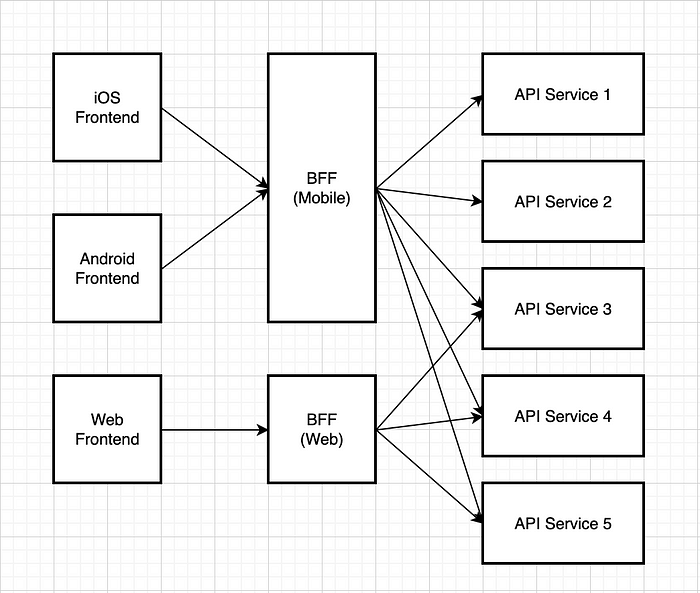Backend for Frontend (BFF) is an architectural pattern designed to address the challenges of serving different types of clients in a modern, distributed application ecosystem. By creating a specialized backend for each type of frontend, BFF ensures tailored responses and better user experiences.
What is Backend for Frontend (BFF)?
BFF is a pattern where separate backend services are created for each type of frontend interface (e.g., web, mobile, desktop). These services are responsible for mediating between the client and the broader set of backend systems or APIs.
Instead of a single, universal backend serving all clients, BFF provides a tailored backend optimized for the specific needs of a particular client. This approach eliminates unnecessary complexity for frontend developers and enhances the overall system’s flexibility.

Why Use BFF Architecture?
BFF architecture is used to:
- Optimize Client-Specific Needs: Each client type (e.g., mobile vs. desktop) may have unique requirements such as data payloads, response times, or API formats. BFF helps address these specific needs.
- Reduce Frontend Complexity: By offloading certain business logic and data transformation tasks to the backend, frontend code becomes simpler and more maintainable.
- Enable Better Decoupling: Different teams can independently develop and maintain their frontends and BFFs.
- Improve Performance: BFFs can handle optimizations like aggregating multiple backend calls into one, reducing the number of network requests.
Where to Use BFF?
BFF architecture is most beneficial in scenarios where:
- Multiple Frontends Exist: When you have diverse frontend clients like a web app, mobile app, or even third-party integrations.
- Client-Specific Optimization is Critical: Some frontends require lightweight responses due to limited network or processing power, such as mobile or IoT devices.
- High Degree of Customization is Needed: Each client has distinct workflows, UI designs, or user experiences that demand tailored data handling.
Real-World Use Cases
1. E-Commerce Platforms:
- Web app: Detailed product descriptions, reviews, and related products.
- Mobile app: Streamlined responses focusing on essential product details and fast loading.
2. Media Streaming Services:
- Smart TVs: Focus on high-resolution media.
- Mobile: Optimized for lower bandwidth and smaller screens.
3. Banking Applications:
- Desktop: Complex reports and dashboards.
- Mobile: Quick balance checks and transaction summaries.
Pros and Cons of BFF Architecture
Pros:
- Enhanced Flexibility: Each BFF can be customized to the frontend’s unique needs.
- Improved Performance: Reduces over-fetching or under-fetching of data.
- Decoupled Development: Frontend and backend teams can work independently.
- Simplified Frontend Code: Complex logic is moved to the backend.
Cons:
- Increased Maintenance: Multiple BFFs mean more services to manage.
- Potential for Duplication: Similar logic may be duplicated across different BFFs.
- Increased Latency: Additional layer between frontend and core backend services.
- Complex Deployment: Deploying and coordinating changes across multiple BFFs and frontends can be challenging.
Best Practices for BFF Implementation
- Clearly Define Responsibilities: Ensure BFF handles only the logic specific to the frontend, avoiding overlap with core backend services.
- Use Consistent Standards: Follow consistent coding, testing, and deployment practices across all BFFs.
- Automate Testing: Include unit, integration, and end-to-end tests for BFFs to ensure they meet client requirements.
- Monitor Performance: Continuously monitor and optimize BFF performance to prevent bottlenecks.
- Scalability: Design BFFs to scale independently to handle increased frontend demand.
- Avoid Tight Coupling: Maintain a separation between BFFs and frontends to allow independent changes and updates.
- Centralize Shared Logic: Extract common functionalities into shared libraries or services to minimize duplication.
Conclusion
Backend for Frontend (BFF) architecture is a powerful pattern for modern applications, especially when supporting multiple client types. By tailoring backend services to specific frontend needs, BFF enhances performance, simplifies frontend development, and improves user experiences. However, its implementation requires careful planning to manage complexity and avoid potential pitfalls. When used correctly, BFF can become a cornerstone of scalable and efficient system design.


Comments
Post a Comment